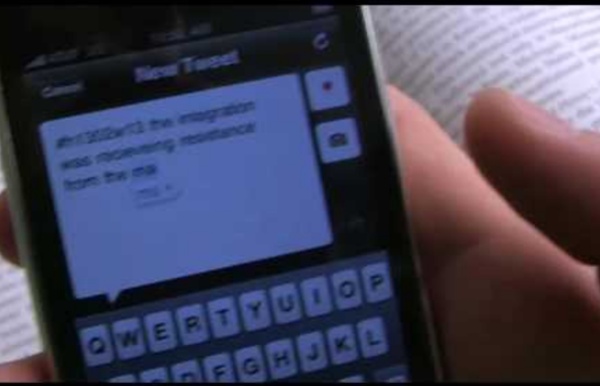YouTube - The Twitter Experiment - UT Dallas
http://www.youtube.com/watch?v=6WPVWDkF7U8
Related: Éducation: informatique et autres outils pédagogiques
• Social Media in English and ESOL Classrooms
The Wired Campus - Professor Encourages Students to Pass Notes D
Cole W. Camplese, director of education-technology services at Pennsylvania State University at University Park, prefers to teach in classrooms with two screens — one to project his slides, and another to project a Twitter stream of notes from students. He knows he is inviting distraction — after all, he’s essentially asking students to pass notes during class.
"Three Ways to Use Twitter in the English Classroom" - Lynn
Recently I’ve been working with some colleagues who are doing great things with Twitter in their English classrooms. I’ve also run into some teachers who are interested in the potential of Twitter but haven’t taken the plunge. So I decided to compile a few examples of how Twitter could be integrated into the English classroom just to provide a place for further discussion and exploration. I would love to hear other ideas for authentic and valuable Twitter integration, so be sure to drop a comment!
Why Teachers Should Join Twitter…What I have Learned as a Twitter Newbie
Adaptivelearnin Profile Okay, I admit that I rebelled against joining Twitter for the longest time. I had friends and family members urging me to join. I often said, “Why should I join another social networking site? I have not used MySpace for a while and am quite happy with Facebook.”
The Twitter Experiment at UT Dallas
Monica Rankin's Home Page Some general comments on the “Twitter Experiment” by Monica Rankin (UT Dallas) There has been a lot of interest in the “Twitter Experiment” video posted by Kim Smith chronicling my U.S. History class at U.T.
"Malvern teacher uses TikTok to meet students where they are, gains 147K followers"
MALVERN, Ark. (KATV) — It’s no secret that between virtual learning and in-classroom instruction, keeping student’s attention through the pandemic has been a struggle for most teachers. That’s why a Malvern Middle School English language arts teacher is meeting students where they already are.
Tweeting the future of student journalism
Today's reporters need to be skilled in multimedia applications, including Twitter—and student journalism programs are reflecting this need. When the undefeated Patriots football team of Freedom High School in Bethlehem Township, Pa., played the Emmaus Green Hornets on Friday night, Freedom senior Tyler Alicea had his heart in the game—and his mind and hands on his phone. Tyler was using his phone to tweet updates about the game while standing in the student section of the bleachers.
Professors experiment with Twitter as teaching tool
Facebook may be the social medium of choice for college students, but the microblogging Web tool Twitter has found adherents among professors, many of whom are starting to experiment with it as a teaching device. People use Twitter to broadcast bite-sized messages or Web links and to read messages or links posted by others. It can be used as a source of news, to listen to what people in certain groups are talking about, or to communicate with experts or leaders in certain fields. Marquette University associate professor Gee Ekachai uses Twitter to discuss what she's teaching in class with students and connect them with experts in the field of advertising and public relations. Instructor Linda Menck, who also teaches at Marquette, encourages students to include social media as a strategy in marketing campaigns for clients. Twitter is helping these professors build community in their classes in a way that appeals to some members of a Facebook-addicted generation.
"How I Use Instagram in High School Language Arts" - Gray
Instagram recently surpassed Snapchat as the favorite social media platform for teens. Like most teachers, reading this statistic compelled an involuntary eye roll, as if I didn’t know my students were glued to their Insta-perfect online lives. But it also led me to ask a question: How could I infiltrate my students’ Insta-world with sneaky lessons and learning opportunities? I started with creating a school Instagram account and went from there. What I learned was that Instagram doesn’t have to be our classroom enemy; we can easily make it our ally. Check out these five easy Instagram-based language arts lessons and assignments to add some digital engagement to your LA classroom.
Related:



This video demonstrates how an instructor uses Twitter for the first time in her large lecture class. Benefits discussed here are similar to other resources: getting quieter students talking, using a world-wide platform that can be accessed anywhere at any time, and leveraging familiar technologies to meet students where they are. by bxharris Mar 11
This video was a perfect example of a teacher who had never used Twitter change to incorporate Twitter in the classroom. Students were able to get out of their comfort zone and become involved in the classroom discussion. I love that their comments were on a live feed on the board so that all students could participate in the discussion. I often find in classroom settings that outgoing students will contribute quite a bit and the shyer students can’t contribute. This is a way that each student can contribute. The teacher was able to participate no matter where she was in the country. This video got me so excited to try this in my own classroom! by scottmckee Oct 31